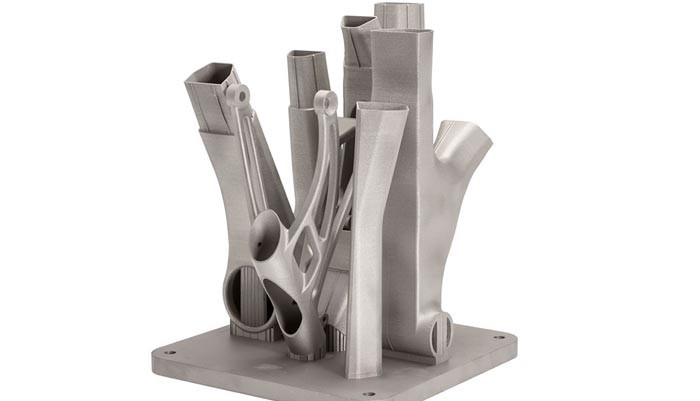The future of bike design may be like ordering a business suit. Tell ‘em your measurements and get your waist, inseam, and suit coat sized how you like them. When it comes to ordering a bike designed totally around your preferences, customization may become the norm rather than the exception.
How? By using a unique combination of additive manufacturing and software technology. In fact, the Robot Bike Co. already offers buyers the opportunity to custom-design the company’s latest offering, the R160 bike, which is manufactured using a combination of 3-D printing and carbon that allows a precise fit for each rider.
WHAT IS ADDITIVE MANUFACTURING?
Additive manufacturing, also called 3-D printing, is a process used to create three-dimensional parts from a digital file. It usually involves building up, or solidifying, thin layers of material to create complete parts. The technology is able to produce complex shapes which cannot be produced by “traditional” techniques such as casting, forging and machining. Additive manufacturing introduces new design possibilities, including opportunities to combine multiple components in production, minimize material use and reduce tooling costs.
FREEDOM TO DESIGN
Bike Robot says its “design freedom" involves “the development of a unique construction using titanium lugs, proprietary carbon fiber components and tubing and a double lap joint bonding concept.”
That’s a lot of fancy talk that essentially means instead of using a fixed mold and set sizes, the R160 is made by bonding carbon tubes to 3D-printed titanium lugs. To do this, the company uses computer generated designs created from titanium powder that is sintered into a solid form by a high-power laser in layers just 60 microns thick.
Each frame can be tailored to a customer’s individual measurements, with the added benefit that the frame can be constantly improved as new technologies emerge because the production process is not constrained by a mold.
As
Jon Woodhouse notes, conventional carbon fiber bike molds limit the sizes available and “preclude any flexibility beyond the layup of the carbon weave. The additive manufacturing process means that the shape of the lugs and hence the geometry of each R160 can be altered with very little difficulty on a bike-by-bike basis.”
The lugs, created from titanium powder that is sintered into a solid form by a high-power laser in layers just 60 microns thick, are grouped together to be produced in a single build.
IT TAKES A VILLAGE OF ENGINEERS
Three of the four partners behind Robot Bike Co. are engineers; the fourth one is a frame design specialist. The partners have allied with three UK-based engineering firms to bring about the R160: HiETA, Altair and Renishaw.
Mike Adams, CEO of HiETA, an additive manufacturing development and project engineering company, cites “mass customization” as a “great aspiration” of additive manufacturing. “Leading this project has allowed us to see integration of all the elements–a great new frame design, the use of state of the art software tools for optimization and automation, the flexibility of the manufacturing process itself and effective collaboration between our partners…” he says.
Altair, a simulation specialist company, was tasked with optimizing the bike’s additively manufactured connecters. It used a unique software program that maximized the benefit of additive manufacturing by identifying where material in the connectors could be removed to save weight and reduce part count without compromising performance.
“This has been a very interesting and exciting project to be involved with,” said Paul Kirkham, team leader with Altair. “Additive manufacturing is the perfect partner for design optimization techniques as it allows us to produce components and systems that are far closer to the ideal balance of weight and performance. Robot Bike Co. now have a design that will offer its customer a bike that is truly innovative and unique.”
Renishaw, a systems manufacturer and solutions provider for additive manufacturing, helped with the initial design concept. According to
Marc Saunders, director of Renishaw’s Global Solutions Center, the titanium lugs are produced using the company’s selective laser melting process, an additive manufacturing technology that can build components directly from CAD geometry using fine metal powders.
The production process starts with bespoke CAD geometries tailored to the customer’s measurements. These are imported into Renishaw's build preparation software, where the optimum orientation for each part is selected and the support structures required for a successful build are specified. Saunders notes that the “11 lugs are grouped together to be produced in a single build. The combined CAD geometry is then ‘sliced' into over 2,500 layers, each 60 microns thick.” Finally, the software defines the scan paths that will be used to melt the titanium powder to produce each layer.
According to Robot Bike Co.’s Ed Haythornthwaite, it doesn’t matter how good a frame is if it doesn’t fit the rider. This is where Robot Bike Co. sees the weakness in the current market offerings.
“If you are trying to produce the very best frame it makes no sense to then only offer it in a small number of sizes when the people you are selling it to come in all shapes and sizes. Think of (us) as the Savile Row of the bike world.”
The R160, which retails for about $6,364 for the frame only, requires a lead time of four weeks to manufacture.




